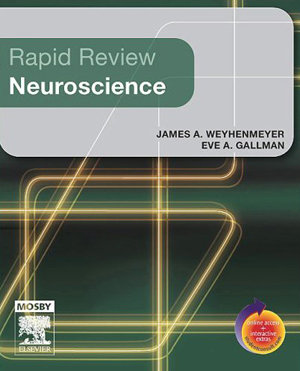해외 입고 상황에 따라 3~4주 정도 소요될 수 있습니다.
Get the most from your study time...and experience realistic USMLE
simulation! These new additions to the Rapid Review Series - highly
rated in the First Aid rankings - make it easy for you to master all
of the basic science material covered on the USMLE Step 1 Exam.
RAPID REVIEW: NEUROSCIENCE Table of Contents Section 1: Macroscopic
Organization: An overview of Nervous System Structure and Function
Chapter I. Anatomy of the Nervous System I. Divisions of the nervous
system II. Dissections III. Horizontal images IV. Coronal images V.
Sagittal images VI. Spinal cord anatomy Chapter II. Development of
the Nervous System I. Neural tube and derivatives II. Neural crest
and derivatives III. Primary vesicles and derivatives IV. Secondary
vesicles and derivatives V. Clinical considerations Chapter III.
Meninges I. Layers of the meninges II. Meningeal vasculature III.
Clinical considerations Chapter IV. The Ventricles and Cerebrospinal
Fluid I. Components of the ventricular system II. Cerebrospinal fluid
(CSF) III. Clinical considerations Chapter V. Vasculature I. Cerebral
blood flow II. Blood-brain barrier (BBB) III. Anterior circulation:
internal carotid system IV. Posterior circulation: vertebral-basilar
system V. Anastomoses VI. Venous drainage VII. Spinal cord blood
supply VIII. Clinical considerations: cerebrovascular accidents
Section 2: Microscopic Organization: The Nervous System at the
cellular level Chapter VI. Neurocytology I. Neurons II. Synapse III.
Neuronal cytoskeleton IV. Axonal transport V. Glia VI. Clinical
considerations: response to injury Chapter VII. Neurophysiology I.
Passive membrane properties II. Excitable membrane III. Myelination
and saltatory conduction IV. Clinical considerations Chapter VIII.
Synaptic interactions I. Electrical synapse II. Chemical synapse III.
Clinical considerations Chapter IX. Neurochemistry I. Classical
neurotransmitters II. Peptide neurotransmitters III. Neurotransmitter
receptors IV. Clinical considerations Section 3: Sensory Systems
Chapter X. Discriminative Touch, Vibration and Conscious
Proprioception I. Sensory receptors II. Dorsal column-medial
lemniscal system - body III. Trigeminal system ? head and neck IV.
Clinical considerations Chapter XI. Pain and Temperature I. Sensory
receptors II. Anterolateral system - body III. Trigeminal system ?
head and neck IV. Clinical considerations Section 4: Motor Control
Chapter XII. Lower Motor Neurons I. Spinal cord anterior horn II.
Cranial motor nuclei III. Neuromuscular junction IV. Clinical
considerations Chapter XII. Upper Motor Neurons I. Corticospinal and
corticobulbar pathways II. "Extrapyramidal" pathways III. Clinical
considerations Chapter XIV. Basal Ganglia I. Function II. Anatomy
III. Basal ganglia circuits IV. Basal ganglia neurotransmitters V.
Clinical considerations Chapter XV. Cerebellum I. Function II.
Cerebellar anatomy related to function III. Cerebellar cortex IV.
Deep cerebellar nuclei V. Cerebellar pathways VI. Clinical
considerations Chapter XVI. Reflexes and their Clinical Significance
I. Overview II. Deep tendon reflexes - clinical considerations III.
Superficial reflexes - clinical considerations IV. Cranial nerve
reflexes - clinical considerations Section 5: Cranial Nerves and the
Special Senses Chapter XVII. Cranial Nerve Overview I. Overview II.
Emergence of cranial nerves III. Locations of cranial nerve nuclei
IV. General sensory input V. Motor control VI. Testing cranial nerves
Chapter XVIII. Visual System I. The eye II. Visual processing within
the retina III. The visual pathway from the retina to the primary
visual cortex Chapter XIX. Auditory System I. What is Sound? II.
Anatomy of the Transduction Apparatus III. Mechanisms underlying
sound transduction IV. Auditory Neural Pathway V. Clinical
Considerations Chapter XX. Vestibu


